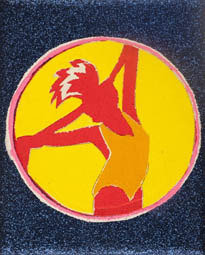Working Against the System
dal 23/6/2011 al 16/7/2011
Segnalato da
Jo Bruton
Debbie Bell
Noel Forster
Yvonne Hindle
Jenny Jennings
Paul Peden
Katie Pratt
DJ Simpson
23/6/2011
Working Against the System
Transition Gallery, London
The second in Transition's series of painting exhibitions draws together eight artists who use and abuse recognised practices in abstract painting. This mutinous crew are self aware and capable of double-dealing as they swerve back and forth between organisation and impulse.

Curated by Helen Baker, the second in Transition's series of painting exhibitions* draws together eight artists who use and abuse recognised practices in abstract painting. This mutinous crew are self aware and capable of double-dealing as they swerve back and forth between organisation and impulse. Many of the artists reclaim systems of production, only to throw the viewer off course by introducing the problematic and employing chance or error. Others defy categorisation by puncturing established processes with spontaneity and intuition. Working Against the System is documented in a new publication, About Painting by Transition Editions.
Jo Bruton examines the desire to perform and transform using visual references to actual performances like the showgirl, cheerleader and circus performer. She flattens form into hard-edged patterns, destabilising our sense of high art through frivolous, graphic stencils and literally kicking the system apart with her can-can style.
Debbie Bell has previously worked with monochromatic systems and now redefines colour as her own ‘thing’, addressing colour as feminine. She is concerned with re-positioning women’s non-representational painting and uses the intuitive feminine self to dislodge the scientific and technical.
Noel Forster employs a set of self-imposed rules in a methodology that is almost ritualistic. However, his system of approach is not the means to an end. The system is a ring fence to procure the chance occurrence or creative error with paint and within the restrictions of the performance. This method and subsequent structure is created by the limitations of the body.
Yvonne Hindle restricts herself to rules, oddly determined by the limited operation of wet paint against wet paint, the operation of gravity, and the sense of power offered by nature outside of human manipulation. These works remind us of the elemental power paint offers in its boundless wet state.
Jenny Jennings confronts her self-imposed grid or pattern with spontaneously generated colour changes; lines become gestures and acts of stylistic rebellion.
Paul Peden determines his own system from a collection of disparate marks. His painted structures sit awkwardly on the surface. Whilst schematic in their process, aspects of the work bear the mark of the hand, allowing the opportunity to explore and accentuate ‘errors’.
Katie Pratt begins with a big, physical gesture then generates a mechanism for making an image that includes meticulous, forensic, picking out and drawing. Interested in the subjective nature of categorisation, she devises rules in order to avoid taste and postpone decision-making, only to then be forced to re-negotiate her own agenda in the process of making.
DJ Simpson reverses the notion that a painting could be described as a once fluid material applied to a solid support. He takes a solid Perspex surface and, through the use of electricity, makes it momentarily fluid to remove material, challenging us to consider what it is we are looking at and raising the criteria for a definition of painting.
Image: Jo Bruton Spotlight Series, 2011, acrylic on canvas, 10x12.5cm each, courtesy the artist and Matt’s Gallery, London.
Preview and launch of About Painting publication Friday 24 June, 6-9pm
Transition Gallery
8 Andrews Road (Unit 25a Regent Studios) London
Hours: Fri-Sun 12-6pm
Free admission



